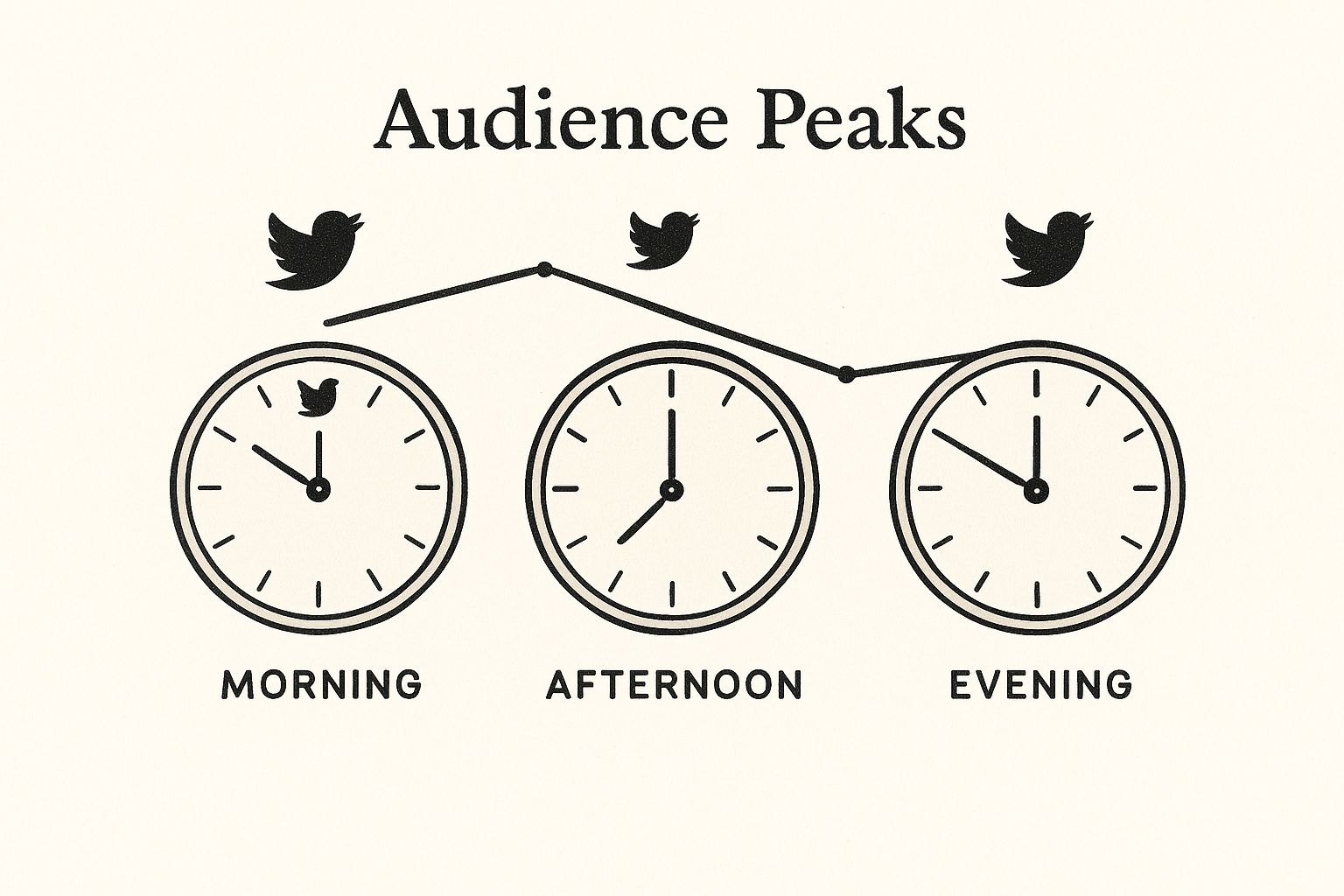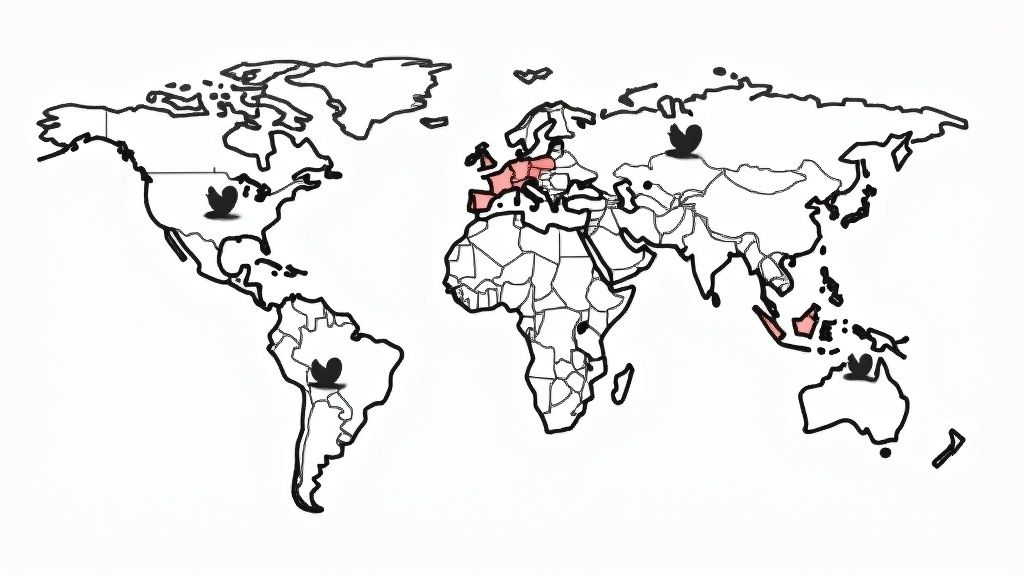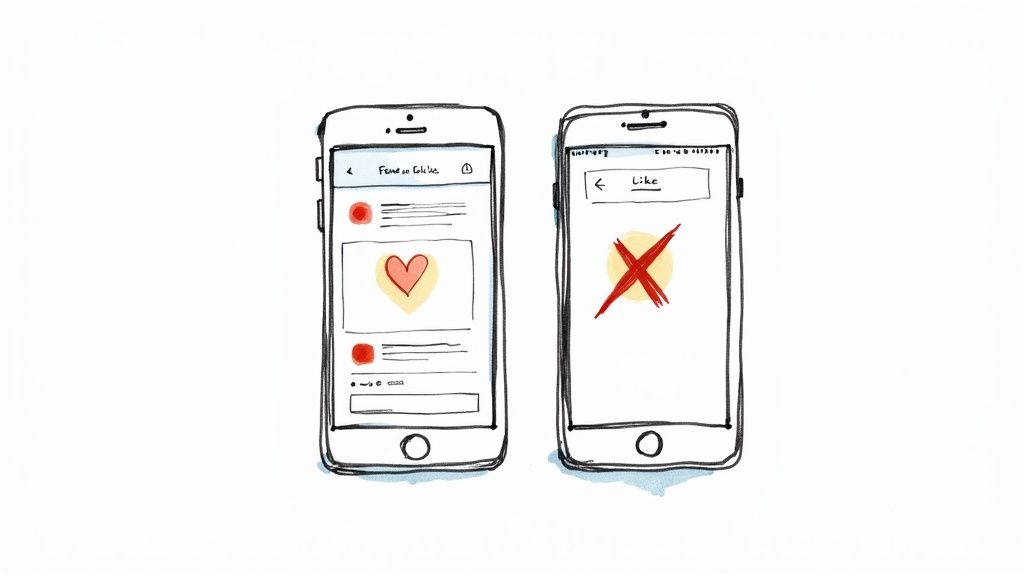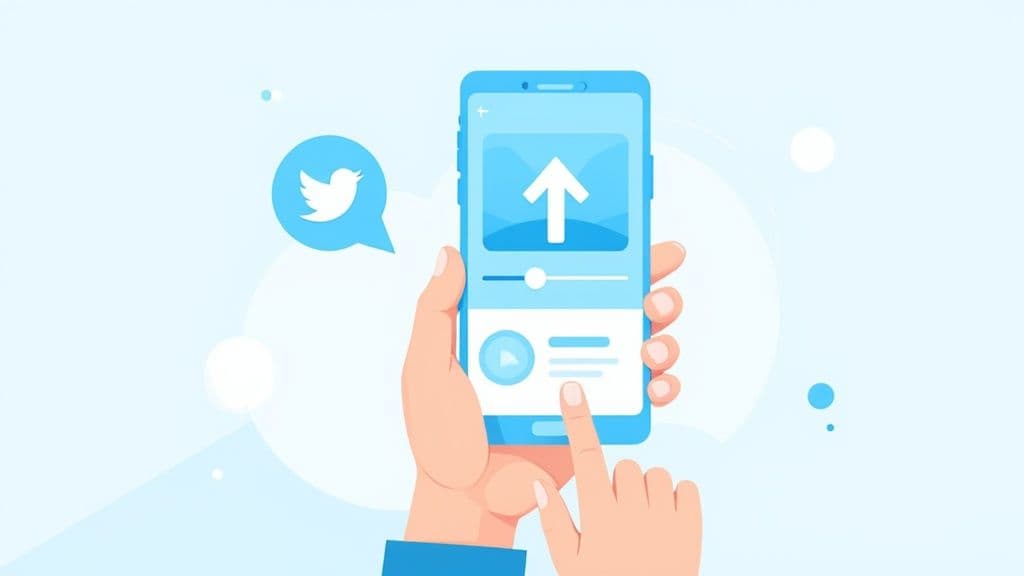Why Your Perfect Tweet Dies in the Twitter Void
You spend twenty minutes writing the perfect tweet. It's witty, insightful, and has all the right hashtags. You hit "Post" and then… nothing. If this scenario is all too familiar, you've met the unforgiving nature of the X (formerly Twitter) timeline. The hard truth is that finding the optimal time to tweet isn't just a minor tweak; it's the one factor that decides if your content gets seen by thousands or just disappears. Even a brilliant post, like one from our X Post Generator, can get lost in minutes if sent at the wrong time.
Think of your tweet as a ship leaving the harbor. Posting when your audience is most active is like launching into a bustling shipping lane, where plenty of other boats (your followers) are around to see you pass. But posting during off-hours is like setting sail into an empty ocean at 3 AM. No matter how impressive your ship is, there's simply no one there to see it.
The Brutal Reality of the Timeline
The X algorithm gives heavy preference to new, fresh content. This gives your tweet a very brief window to make an impression and get that initial burst of engagement. A tweet sent at 9 AM, when many people are starting their day and scrolling through social media, can catch this first wave of likes and replies. The algorithm registers this activity and shows your tweet to more people, creating a positive feedback loop.
Now, imagine that same tweet posted at 9 PM when your audience is offline. It gets almost no initial interaction. It effectively sinks without a trace, buried under the continuous stream of new posts from other accounts.
This fast decay is why timing is such a strategic move. Posting on X at the right moment can dramatically increase your engagement, which is especially important when you consider that user sessions on the platform average only about 3 minutes. The fast pace means your carefully written content can get lost in the feed if it doesn't appear at the exact moment your audience is scrolling. You can explore more data on the impact of timing on engagement on sproutsocial.com.
The Psychology of Peak Engagement
To understand why certain times perform better, you need to think about human routines and daily habits. Peak usage on social media often lines up with predictable moments in our day:
- Morning Commute: People check their phones on the bus or train on their way to work.
- Lunch Breaks: A midday break is a perfect time to catch up on news and social feeds.
- Late Afternoon: As the workday winds down, many people take a quick mental break and scroll through their timelines.
By recognizing these patterns, you can stop leaving your content's success to pure luck. Instead of just posting and hoping for engagement, you can start thinking like a strategist, using timing to make sure your great ideas get the visibility they deserve.
What Million-Tweet Analysis Reveals About Peak Hours
Instead of relying on guesswork, we can turn to large-scale data to find clear answers about tweet timing. When researchers analyze massive datasets—sometimes with over a million tweets—distinct patterns show up, revealing when users are most active. This isn't just about counting likes; it’s a deep dive into when people are most likely to click, reply, and share content. These studies offer a solid foundation for any timing strategy.
This type of analysis is effective because it uncovers predictable human behaviors. Think of it like rush hour traffic on a highway. Just as roads get congested at certain times, digital traffic on X (formerly Twitter) surges during specific windows. By understanding these high-traffic periods, you can schedule your content to go live when the "digital highways" are busiest, making sure more people see it.
General Peak Engagement Windows
The broad consensus from these large studies points to a consistent trend: weekday mornings are prime time. This is when people are settling into their work routines, scrolling through news, and taking their first social media breaks of the day. Engagement usually stays strong through the early afternoon before it begins to drop off.
This infographic illustrates the general daily rhythm of audience activity, showing the typical swells during the morning, afternoon, and evening.

The visualization clearly shows that the morning hours are the most concentrated period for high engagement, making it a critical window for posting important content.
Pinpointing the Best Times
Digging deeper into the data gives us even more specific targets. The table below, based on an analysis of over 1 million tweets, breaks down the best times to post for each day of the week.
Peak Twitter Engagement Times by Day
Comprehensive breakdown of optimal posting times for each day of the week based on million-tweet analysis
| Day | Primary Peak Time | Secondary Peak Time | Engagement Rate Increase |
|---|---|---|---|
| Monday | 8:00 AM | 12:00 PM | +12% |
| Tuesday | 8:00 AM | 1:00 PM | +15% |
| Wednesday | 9:00 AM | 3:00 PM | +18% |
| Thursday | 8:00 AM | 9:00 AM | +14% |
| Friday | 9:00 AM | 11:00 AM | +11% |
| Saturday | 10:00 AM | 1:00 PM | +8% |
| Sunday | 11:00 AM | 2:00 PM | +6% |
As the data shows, Wednesday at 9 a.m. emerges as the single best time to post for maximum engagement. Other highly effective slots include Tuesday at 8 a.m. and Monday at 8 a.m., highlighting how crucial the start of the workday is for reaching an active audience. You can read the full research on optimal tweet timing from Buffer to see a more detailed breakdown.
Of course, these times represent global averages. Think of them as a well-drawn map showing the main roads. They provide an excellent, data-backed foundation for discovering your optimal time to tweet. The next step is to overlay this map with the unique traffic patterns of your own specific audience. By using these broad insights as your guide, you can start experimenting with precision, knowing you are starting from a position of statistical strength rather than a shot in the dark.
Decoding Your Audience's Hidden Twitter Rhythms
Behind every username is a real person with daily patterns, and learning these rhythms is your secret weapon. Your followers don't just scroll at random; they check Twitter at specific times that fit into their lives, work schedules, and personal habits. Imagine it like a neighborhood coffee shop. It isn't packed all day long—it has a morning rush, a quiet period midday, and another spike after work. Your job is to serve your best content just as the line starts forming out the door.
To find your own optimal time to tweet, you need to look past general advice and dig into the human behaviors that drive your specific audience's activity. The first step is to think about their likely daily routines.
Identifying Your Audience's Daily Flow
Are you talking to students, 9-to-5 professionals, or creatives with unconventional hours? Each group has a distinct digital pulse.
- Professionals in an Office Setting: They often browse social media during their morning commute, grab a quick look during their lunch break around noon, and scroll again as the workday finishes in the late afternoon.
- University Students: Their schedules can be more irregular, but they frequently engage late at night after studying or between classes throughout the day.
- Parents of Young Children: They might be active early in the morning before the school run or later in the evening once the kids are asleep.
This thinking is supported by Twitter's user demographics: 36.6% of users are aged 25-34 and 34.2% are aged 18-24. These are groups most likely to be checking their phones as they settle into their workday. You can discover more about Twitter user demographics on Buffer.
From Online to Mentally Present
Just because someone is online doesn't mean it's a good time to reach them. The goal is to find moments when your followers are not only scrolling but are also mentally present and receptive to new ideas. A person quickly checking notifications between meetings has a very different attention span than someone relaxing on their couch in the evening.
By observing your analytics and comparing them to your audience profile, you can develop a solid understanding of your community's unique Twitter habits. This knowledge is the bedrock of any successful timing strategy, moving you from generic tips to a personalized and much more effective approach.
Mastering Weekday vs. Weekend Twitter Strategies
Twitter's personality changes dramatically when Friday afternoon rolls around, and your strategy needs to shift with it. The focused, professional check-ins that define weekday mornings give way to leisurely weekend scrolling. This creates entirely new opportunities for engagement that many accounts miss. Understanding this shift is the key to finding your optimal time to tweet every day of the week.

Weekday vs. Weekend Mindset
Think of your audience's timeline scrolling habits. During the workweek, users often scan their feeds for quick news, industry updates, and professional connections. Their engagement is frequent but brief—like grabbing a quick coffee between meetings.
On weekends, however, the mindset shifts to personal interests, hobbies, and entertainment. Users are more relaxed, spend longer sessions on the platform, and are more willing to dive into deeper content like threads, videos, and polls. This creates a chance to build a community rather than just broadcast information.
Data backs up this behavioral change. Weekday engagement often peaks in focused bursts, such as between 8 a.m. and 11 a.m., with another bump around 3 p.m. as the workday winds down. In contrast, the weekend engagement window broadens considerably, stretching from 9 a.m. all the way to 8 p.m. This wider, more consistent activity offers a larger playing field. You can discover more insights about these engagement patterns from an analysis by SocialPilot.
To help visualize these differences, here’s a comparison of how you should approach each period.
| Time Period | Weekday Peak Hours | Weekend Peak Hours | Engagement Duration | Content Type Performance |
|---|---|---|---|---|
| Weekdays | 8 a.m. – 11 a.m., 3 p.m. | – | Brief, frequent check-ins | Industry news, quick tips, professional advice, breaking updates |
| Weekends | – | 9 a.m. – 8 p.m. | Longer, more relaxed sessions | Behind-the-scenes stories, polls, Q&As, hobby-related content, videos |
The table clearly shows that weekdays are for quick, valuable information, while weekends open the door for deeper, more personal connections with your audience.
Adapting Your Content Strategy
This behavioral shift means your content must adapt. While professional advice and industry news perform well from Monday to Friday, weekends are the perfect time for a different approach.
- Humanize Your Brand: Share behind-the-scenes content, team stories, or lighter, more personal updates. Let your audience see the people behind the logo.
- Engage with Hobbies: Post about topics that align with your brand's values but are geared toward leisure, such as books, movies, or weekend projects.
- Ask Questions: With more time on their hands, users are more likely to respond to polls and open-ended questions, which can spark valuable conversations.
By adjusting your tone and content, you can connect with your audience on a more personal level. For instance, using a tool to generate engaging questions can help foster this weekend interaction. If you're looking for ideas, the principles in our guide on the Postiz YouTube Comment Generator can be applied to spark conversations on any platform.
When Breaking The Rules Leads To Breakthrough Results
While data provides an excellent map, experienced marketers know the most interesting places aren't always on the main road. If you only post during peak hours, you’re jumping into a crowded pool where everyone is fighting for the same attention. Sometimes, the best results come from strategically breaking the rules and posting when it’s supposedly "quiet." Finding the optimal time to tweet is just as much about spotting unique opportunities as it is about following patterns.
Think about it this way: a major news story about your industry breaks at 7 PM on a Friday. Standard data says this is a terrible time to post. But the context changes everything. At that exact moment, a huge, highly focused audience is rushing to Twitter for live updates. Posting then isn’t just a good idea; it's a chance to catch a wave of engagement that a scheduled 9 AM tweet would completely miss.
Capitalizing on Context and Niche Rhythms
Your industry might operate on a completely different clock than the general population. For example, the gaming community is famously active late into the night, a time that would be a dead zone for most B2B companies. A tweet announcing a new game update at 11 PM could easily get more traction than one sent during the morning rush hour. Likewise, a timely tweet during a live sports final or a popular TV show can capture a massive audience engaged in "second-screen" viewing.
This is where your human judgment becomes more powerful than any dataset. Always be on the lookout for these kinds of situations:
- Live Events: Are your followers watching a conference, webinar, or awards show? Join the conversation and tweet along with them.
- Trending Topics: Can you create content that adds real value to a trending hashtag or conversation? This is your ticket to being seen by a much larger audience.
- Global Audiences: If a large portion of your followers lives in a different time zone, their "peak" hours are your "off-peak" hours. Scheduling posts for their morning can be a very effective strategy.
When Your Content Dictates the Time
The type of content you share also has its own ideal schedule. A long, detailed thread that requires deep reading might get lost in the fast-paced scroll of a busy workday morning. That same thread, however, could be perfect for a Sunday afternoon when people have more time to relax and read. In contrast, a quick meme or an engaging poll is the perfect bite-sized content to break through the noise during a busy peak period.
Ultimately, data gives you the foundation, but your intuition and awareness of the current moment are what build the skyscraper. Treat the established peak times as your reliable default setting—they will consistently bring you solid results. But always keep your eyes open for those moments when breaking the rules is the smartest move. It’s this combination of data-backed scheduling and agile, context-aware posting that leads to real growth and viral potential.
Creating Your Personal Optimal Timing Blueprint
Generic advice and broad industry studies are great starting points, but true success comes from a strategy that is fitted to your unique audience. Think of general data as a master blueprint for a house; it’s solid and well-designed, but you still need to choose your own paint colors and furniture. This is where you move from theory to practice and discover your personal optimal time to tweet.

Step 1: Track Your Tweet Performance
Your journey starts with collecting data. For the next two to four weeks, make a point to post at various times and on different days. This means you’ll need to intentionally post outside of your usual habits. If you always post at 9 AM, try scheduling some tweets for noon, 3 PM, and even 8 PM. The goal is to gather a wide range of data points that show how your content performs throughout the day.
You can set up a simple spreadsheet to monitor this. For each tweet, log the following information:
- Day of the Week: Monday, Tuesday, etc.
- Time of Day: The exact time you posted.
- Tweet Content: A short description or a link to the tweet.
- Engagement Metrics (after 24 hours): Impressions, likes, replies, and retweets.
This systematic method gets rid of the guesswork and gives you hard facts about what actually works for your account.
Step 2: Analyze the Data and Find Your Peaks
After a few weeks of tracking, patterns will start to show up in your spreadsheet. Search for the "hot spots"—those specific times and days that consistently bring in the highest engagement. Don't just look at likes; pay close attention to impressions and replies, as these metrics often point to a more active and interested audience. You might discover that while 9 AM on Wednesday gives you good impressions, 4 PM on Thursday leads to more meaningful conversations.
This process turns your Twitter analytics from a confusing mix of numbers into a clear map that pinpoints your audience's peak activity periods.
Step 3: Test and Refine Your Schedule
Once you've identified your initial hot spots, it's time to run some controlled experiments. For one week, schedule your most important content during these newfound peak times. Then, compare the results to your previous performance benchmarks. Did your overall engagement rate increase? Did you notice more replies and website clicks?
As you start to build your own timing strategy, combining it with broader social media content planning strategies can amplify your results. This isn't a one-and-done task but a continuous cycle of posting, tracking, analyzing, and adjusting. By consistently paying attention to what your data reveals, you'll develop a personalized timing strategy that beats any generic advice and only gets better over time.
Turning Timing Knowledge Into Sustainable Success
Knowing the theory behind the optimal time to tweet is one thing; turning that knowledge into consistent results is another. Insights without action get you zero retweets. This final step is about creating a practical, sustainable system that boosts your Twitter presence without chaining you to a posting calendar. It’s about building a workflow that feels both strategic and authentic.
Building Your Content Workflow
A successful timing strategy doesn’t mean living on Twitter, waiting for the perfect moment to post. Instead, it relies on preparation and smart automation. Think of it like meal prepping for the week. Batch content creation is a popular technique where you dedicate a block of time each week to write multiple tweets at once. This approach ensures you always have high-quality content ready to go for your peak engagement slots.
Once you have a bank of content, you can set up a realistic scheduling workflow. The key is to find a good balance between automation and genuine, real-time interaction.
- Schedule Your Core Content: Use a tool to schedule your most important updates, threads, and promotional posts during your identified peak times.
- Leave Room for Spontaneity: Your calendar shouldn't be set in stone. Always leave some open space to react to trending topics, breaking news, or unexpected conversations.
- Maintain Consistency: Aim to post regularly during your high-engagement windows. This helps train both the algorithm and your audience to expect content from you at those times.
The Postiz dashboard provides a clear visual of your content calendar, which makes planning and scheduling posts much simpler.
This view allows you to see your entire week at a glance, ensuring a healthy mix of scheduled content and open slots for spontaneous engagement. To truly get the most from your efforts, it helps to understand broader strategies for increasing social media engagement.
Scaling and Adapting Your Strategy
Your first timing strategy is just a starting point, not a permanent rulebook. As your audience grows or your brand's focus changes, your best posting times might shift. It’s a good idea to check your analytics—at least once a quarter—to confirm if your peak times are still giving you the best results. For instance, a growing international following might mean you need to add new posting times to reach different time zones.
Just as your social strategy adapts, so should your content across different platforms. The principles of creating a compelling bio for one network can often be adapted for others. If you're looking for inspiration, you might find our guide on the Postiz TikTok Bio Generator useful.
By combining batch creation, smart scheduling, and ongoing analysis, you build a powerful system. You’ll not only hit your optimal posting windows consistently but also do it efficiently. This frees up your time to focus on what really matters: creating great content and building a real community.
Ready to turn your timing knowledge into real growth? Start using Postiz today to schedule your posts, analyze your performance, and build a sustainable strategy that works.





